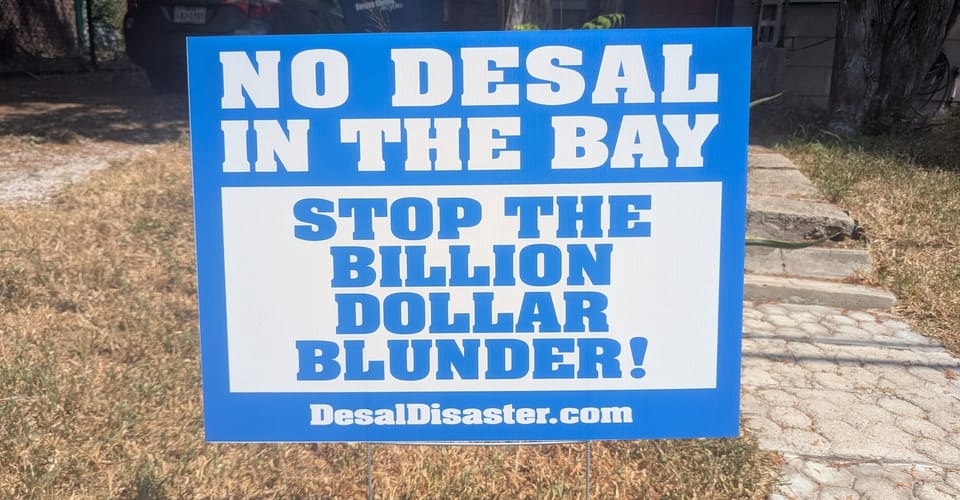Op-ed: Here’s why the City Council should pursue the most affordable, least risky water projects

By Jason Hale
Nine years ago, Phase 2 of the Mary Rhodes Pipeline went online. At a cost of $126 million, it promised to deliver over 30 million gallons a day of water to the Coastal Bend from the Colorado River, over 100 miles away. But since 2017, that water supply has only delivered 33% of its capacity, resulting in a 60 billion gallon shortfall that ultimately had to be drawn from our western reservoirs, Lake Corpus Christi and Choke Canyon.
What’s strange about this is that throughout the entire nine-year period, Corpus Christi Water (CCW) has spent most of its energy developing a new water supply, the Inner Harbor seawater desalination plant, that has been planned to deliver a similar amount of water as Mary Rhodes Phase 2, but at a cost almost 10 times as much – $1.2 billion.
Read more: Texas Desal Association: Hookups and Conflicts for CCW’s Drew Molly?
Now Coastal Bend residents are rightly upset, because had CCW prioritized maximizing our existing water supplies instead of focusing solely on the Inner Harbor project, we wouldn’t be in Stage 3 drought restrictions. Our reservoir storage levels would be higher than what they were a year ago, and they wouldn’t be two years away from running dry. Yet here we are, with signs all over town warning that ‘every drop counts’.
Thankfully, some Corpus Christi City Councilmembers had the foresight to push CCW to explore more affordable options, resulting in an Alternative Water Supply Workshop in March of this year. The workshop covered a wide variety of supply strategies, from multiple brackish groundwater desalination projects (a cost-effective strategy that is tried and true throughout Texas) to wastewater reuse (something that would make the most out of the water we already have) and even a floating solar panel project that could reduce evaporation in our lakes while also generating a profit for the City. For the first time, it felt like we actually had numerous opportunities to secure our water future.
Fast forward to today, and our region is at a crossroads on where to go next for new water. Council very recently approved funding for one of the cheaper alternatives presented in the workshop, the Evangeline Laguna groundwater project, but as of now the fate of the Inner Harbor desalination plant remains to be decided. With $34 million spent and $200 million in loans on the Inner Harbor project, a lot is at stake.
Proponents of the Inner Harbor say we need it now, that we’ve already invested a lot in it, and that it’s only going to get more expensive as time goes on, most of which is true. However opponents of the project are deeply concerned that the costs are already too high and that the true risks of the plant are still unknown. For example, it’s still not known if discharging super-salty waste from desalination into the bay would create “dead zones” or harm the health of our coastal ecosystem, or if carcinogenic “forever chemicals” could flow through our taps if the reverse osmosis membranes don’t function properly.
However what is very clear, to me and others, is that our water dollars could and should be going to projects that would be simpler, more reliable, and easier to maintain than a seawater desalination plant. We now know that we have plenty to choose from.
Remember, it took eight years for CCW to get the Mary Rhodes pipeline running at full scale, despite pipelines being what Texas does best. If they can’t get that right, how long will it take them to get a state-of-the art seawater desalination plant to run at full scale? How many projects will we have missed out on in the meantime? And will someone else take advantage of those lower-cost projects if we don’t? (The answer is yes.)
If every drop counts, then so does every dollar. We can no longer afford to keep putting money into the Inner Harbor when there are clearly more cost-effective options available. Sure, the City has spent a lot of money on the Inner Harbor, and some may view it as a sunk cost, but I see it as a fee for an invaluable lesson. We learned that seawater desalination is massively expensive, that there are far cheaper options available, and that there are plenty to choose from – so what are we waiting for? I urge our City Council to take action now. Stop throwing money into the Inner Harbor and to start investing responsibly in our community's future.
More desal coverage:
